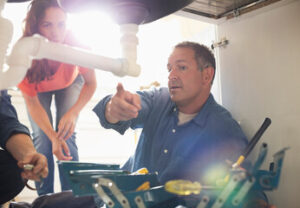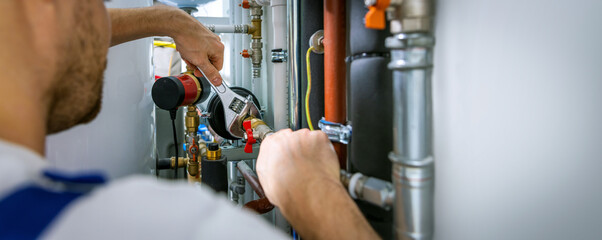Plano Plumbing is essential for maintaining a functional and healthy environment. It involves the installation and repair of water and drainage systems. A well-designed plumbing system ensures clean water supply and efficient waste removal. Skilled plumbers manage the complexity of these systems with precision.
The design of a plumbing system starts with understanding water flow and pressure. Pipes must be properly sized to handle the volume of water. Incorrect pipe sizing can lead to low pressure and drainage issues. Plumbers calculate these factors to create a balanced system.
Water supply systems rely on consistent pressure to deliver water effectively. Pumps and valves control the flow and distribution. Pressure regulators prevent damage to fixtures and appliances. Maintaining proper pressure ensures efficient performance and reduced wear.
Drainage systems remove wastewater safely and efficiently. Gravity plays a key role in moving waste through pipes. Proper slope and pipe sizing prevent blockages and backups. Venting allows air to escape, ensuring smooth drainage flow.
Pipe materials affect the durability and performance of a plumbing system. Modern plumbing uses various materials suited for different applications. Corrosion resistance and flexibility determine material choice. Proper installation prevents leaks and structural damage.
Plumbing fixtures require precise installation and sealing. Faucets, sinks, and toilets must connect seamlessly to supply and drainage lines. Improper sealing can lead to leaks and water damage. Skilled plumbers ensure secure connections and leak-free performance.
Hot water systems depend on heaters and insulated pipes. Proper installation reduces heat loss and improves energy efficiency. Temperature control valves prevent scalding and damage. Plumbers calculate water demand to size systems accurately.
Leak detection involves locating hidden leaks in walls and floors. Plumbers use advanced tools like pressure tests and thermal imaging. Early detection prevents water waste and structural damage. Prompt repair restores system integrity and efficiency.
Backflow prevention protects clean water from contamination. Check valves and air gaps prevent wastewater from reversing flow. Plumbing codes mandate backflow prevention in specific systems. Proper installation ensures compliance and health safety.
Septic systems treat and dispose of household wastewater. Tanks separate solids from liquids, allowing natural treatment. Drain fields distribute treated water into the ground. Regular maintenance prevents overflow and system failure.
Stormwater management prevents flooding and water damage. Gutters and drainage systems direct rainwater away from structures. Proper grading and pipe placement control water flow. Effective stormwater systems protect property and infrastructure.
Frozen pipes pose a risk in cold climates. Expanding ice can crack or burst pipes. Insulation and heat tracing protect vulnerable pipes. Thawing requires controlled heating to prevent further damage.
Water filtration systems improve water quality and taste. Filters remove contaminants like sediment, chlorine, and minerals. Reverse osmosis and carbon filtration are common methods. Regular filter replacement ensures consistent performance.
Water softening reduces mineral buildup in pipes and fixtures. Hard water contains calcium and magnesium that cause scaling. Water softeners exchange minerals for sodium or potassium. Reduced scaling improves plumbing lifespan and water flow.
Gas plumbing involves installing and maintaining gas lines. Proper sealing and pressure regulation prevent leaks and hazards. Gas appliances require specific venting and safety controls. Skilled plumbers follow strict safety codes for gas installations.
Plumbing renovations require detailed planning and execution. Existing systems must be assessed for compatibility and capacity. Upgrading pipes and fixtures improves efficiency and water quality. Proper permits and inspections ensure code compliance.
Commercial plumbing systems handle higher water volumes and usage. Larger pipes and fixtures withstand increased demand. Pressure balancing and drainage capacity are key design factors. Regular maintenance prevents downtime and repair costs.
Industrial plumbing systems require specialized materials and designs. High-pressure systems and chemical exposure demand durable components. Corrosion-resistant materials prevent system failure. Industrial plumbers follow strict safety and performance standards.
Plumbing for medical facilities requires sanitary and reliable systems. Medical-grade piping prevents contamination and ensures clean water. Backflow prevention and filtration protect patient health. Emergency water supplies maintain operation during outages.
Fire sprinkler systems depend on pressurized water lines. Pipes and sprinkler heads activate when heat reaches a specific threshold. Proper pipe sizing and pressure ensure even water distribution. Regular testing ensures reliable operation in emergencies.
Plumbing for multi-story buildings requires pressure zoning. Pumps and pressure-reducing valves balance water flow between floors. Drainage systems require venting and proper slope. Skilled design prevents pressure loss and drainage issues.
Plumbing inspections identify hidden issues before they cause damage. Pressure tests and camera inspections reveal leaks and blockages. Preventative maintenance extends the lifespan of plumbing systems. Early repairs reduce repair costs and water waste.
Plumbing codes and regulations protect public health and safety. Local codes specify pipe materials, fixture installation, and backflow prevention. Compliance ensures proper system function and safety. Plumbers stay updated on code changes to maintain compliance.
Emergency plumbing services address sudden leaks, blockages, and failures. Rapid response minimizes water damage and restores system function. Emergency plumbers carry specialized tools and replacement parts. Quick diagnosis and repair prevent further complications.
Plumbing for green buildings emphasizes water efficiency and sustainability. Low-flow fixtures and water recycling systems reduce waste. Rainwater harvesting and greywater reuse improve resource management. Green plumbing reduces environmental impact and operating costs.
Plumbing automation improves system monitoring and control. Smart leak detectors and pressure sensors provide real-time alerts. Automated shut-off valves prevent flooding and water waste. Remote monitoring ensures quick response to issues.
Plumbing in historical buildings requires careful restoration. Preserving original materials and designs is a priority. Modern plumbing upgrades improve functionality without altering character. Skilled plumbers balance preservation with performance improvements.
Outdoor plumbing includes irrigation systems and hose connections. Proper pipe placement and slope prevent freezing and damage. Drip irrigation and moisture sensors improve water efficiency. Outdoor plumbing extends functionality to gardens and landscapes.
Plumbing in remote areas requires self-sufficient systems. Well water and septic systems provide independent water supply and waste disposal. Solar-powered pumps and water tanks improve reliability. Skilled design ensures consistent performance in off-grid locations.
Water conservation methods improve plumbing efficiency. Low-flow toilets and faucets reduce water consumption. Greywater recycling reuses water for irrigation and flushing. Efficient plumbing design reduces utility costs and environmental impact.
Plumbing for pools and spas requires chemical-resistant materials. Filtration and circulation systems maintain water quality. Heater and pump installation require precise pressure balancing. Proper maintenance prevents equipment failure and water imbalance.
Plumbing for heating systems includes radiators and underfloor heating. Hot water circulation requires balanced pressure and flow. Pipe insulation reduces heat loss and improves efficiency. Skilled installation ensures even heating and comfort.
Plumbing repairs involve diagnosing and fixing various issues. Leaks, clogs, and pressure loss require targeted solutions. Replacement of damaged pipes and fittings restores system integrity. Professional repairs ensure long-term performance and safety.
Plumbing upgrades improve efficiency and performance. Replacing old pipes and fixtures reduces leaks and water waste. Modern materials and designs improve pressure and flow. Upgrades increase property value and reduce maintenance costs.
Plumbing for agricultural systems includes irrigation and drainage. Water flow and pressure affect crop health and yield. Drip and spray irrigation improve water distribution. Proper pipe installation ensures even watering and reduced waste.
Plumbing for food and beverage production requires sanitary systems. Stainless steel pipes resist corrosion and contamination. Backflow prevention and filtration ensure product safety. Consistent water pressure supports production efficiency.
Plumbing expertise ensures the safe and reliable delivery of water and removal of waste. Skilled plumbers balance pressure, flow, and drainage for optimal performance. Proper installation and maintenance prevent issues and extend system lifespan. Effective plumbing supports comfort, health, and safety in residential and commercial settings.

